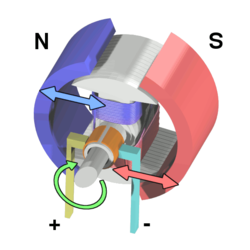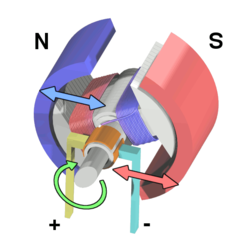Relevant Technical Information
Batteries
Lithium batteries are used for almost all applications where energy density is important.. Basically anything that moves. LiPo cells are pouch shaped and rectangular, while Li-Ion cells are cylindrical, like a standard AA battery.
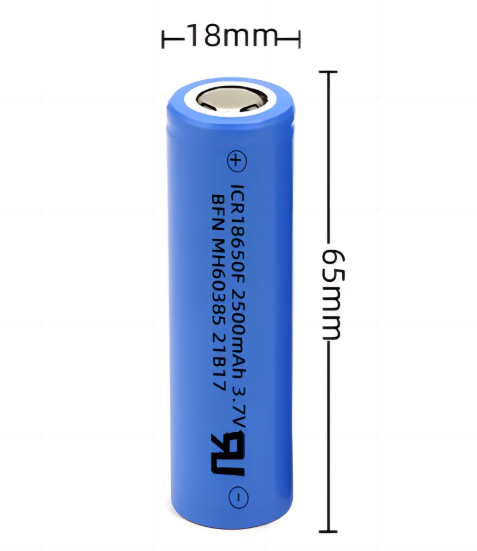
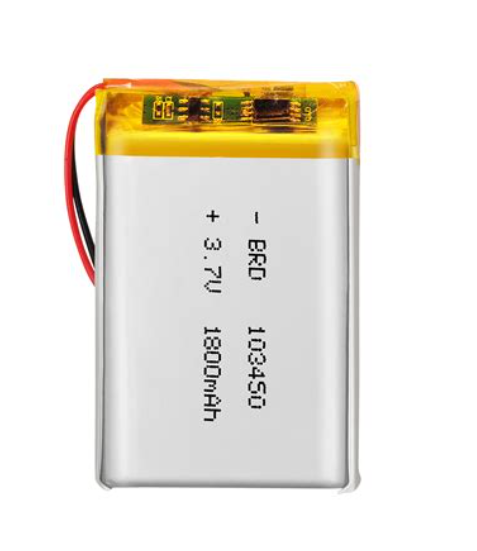
Batteries are rated in a few ways…
Ratings and Specifications
Capacity
The total energy content, measured in Milliamp Hours (mah) which the battery contains. Needs to be multiplied by nominal voltage to get an actual unit of energy, usually Milliwatt hours (mwh) or just watt hours (wh).
Since one milliamp refers to electrons per second, a milliamp hour is total electrons. That’s not a unit of energy because there’s no difference in potential considered. It’s like saying asking “How much energy does it take to pump 10 gallons of water?” you’d need to know how fast, through what pipe, and over what distance and difference in height.
Multiplying the battery’s “capacity” in amps or milliamp hours by it’s average voltage (which is really integrating the product of the cells voltage and current over time as it’s discharged) gives you the total energy capacity of the battery in watt-hours (Wh). Since a watt is a unit of power (energy / time), multiplying it by a period of time (like an hour) gives you a unit of energy. One watt-hour is 3600 Jules.
Nominal Voltage
The average voltage of the battery during it’s discharge curve over capacity, not time. Capacity which can’t safely (or repeatedly) extracted isn’t considered part of the discharge curve, so the range of voltage between the battery’s minimum voltage and 0 isn’t considered.
Discharge / Charge Rate
Battery’s have ratings for how quickly they can be charged and discharged without significant damage. Usually, manufacturers also indicate for how many charge/discharge cycles a battery will maintain above 80% capacity when charged/discharged at different rates. Charge and discharge rates are measured in “C”, which refers to the mah capacity of the battery. Discharging a 2500 mah battery at 1C means you are pulling 2.5 amps from it. Incedentally, discharging any battery at 1C is possible for exactly 1 hour.
Here’s a community test of the Samsung 25R cell’s capacity vs. cycles at 2.5A and 4A, both well under the cells 20A discharge rating:
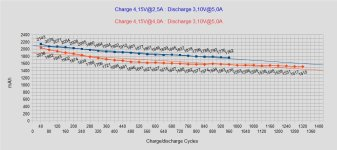
This is one reason why charging your phone slowly at night (like with a normal 5W usb) will extend it’s battery life.
There are many, many other things which impact cell degradation, for example the top and bottom ~10% charge states are exponentially more chemically stressful for batteries. Charging a 4.2v rated li-ion to only 4.1v leaves ~6% capacity on the table but reduces degradation rate by about 1/2, for example.
It also takes longer to charge at the very bottom and top SOC (state of charge), which is why EV route planning apps (like the amazing ABRP) almost never plan for you to charge all the way to 100% - it takes much longer than it’s worth.
One reason it takes longer to charge at high SOC is because there’s less voltage margin to motivate charging. Batteries have ISR (internal series resistance) which means in order to get current to flow into a battery, you have to use a power source which has a higher voltage than what the battery is currently at. The samsung 25R cell has an ISR of , so using , we can figure that if we don’t want to risk overcharging accidentally, if we are giving it 4.2, we can only get worth of charge current. As the cell approaches full, our charge current approaches zero. For the last ~6% of the cells voltage (between 4.128v and 4.2v), a normal CV (constant voltage) charger can’t charge it at it’s rated 4A charge current. It’s much worse than this through, because the allowable charge current drops off as the battery gets full because more energy is lost to heat and the battery can’t be charged while it’s too hot.
At the end of the day, rated charge/discharge rates are slightly made up, and some manufactures even sell the same exact cell with different datasheet and part number as a lower life expectancy but higher power version. For any cell, pushing/pulling more current will degrade the cell faster, and you only have to stay inside the charge rating if you want to pass of any fire related law suits to the cell manufacturer.
Discharge Curve / Max and Min Voltage
Battery’s have a minimum and maximum safe voltage, outside of which they are chemically damaged or even catch fire. Most lithium based battery’s have a maximum voltage around 4.2v and a minimum around 3.1v.
Battery’s do not discharge linearly. Each cell model has a voltage vs. remaining capacity curve in it’s datasheet, usually one with different lines for temperature, and one with different lines for discharge rate.
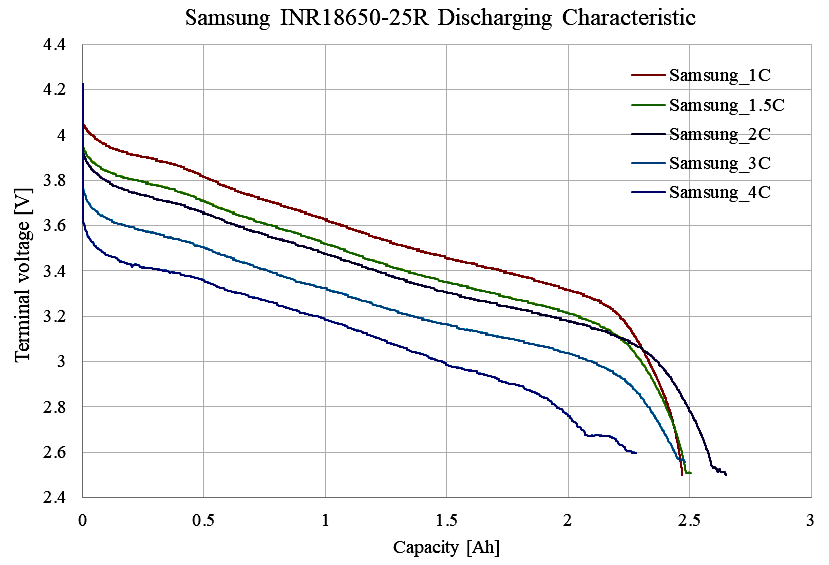
Battery Packs
In many applications, higher than 3.6v is needed from a battery. To achieve this, individual cells are arranged in series. By putting two li-ion cells in series, you get a pack nominal voltage of 7.2v. While cells do come in bigger sizes with larger mah capacities, it’s also common to arrange multiple cells in parallel to increase capacity without increasing voltage. Packs are described by their ovverall voltage, and overall mah capacity. For example, a pack of samsung 25R 2500mah cells with 10 series groups of 2 cells would be called 36v 10s2p with 5ah. On the inside, it would look something like this:

Note that cells are connected in parallel first, then in series. Also, the flip-flop architecture here where cells alternate in physical direction is very common, even in toys that take AA or AAA batteries. For this battery to be safe, there would also be a BMS with taps going to each black bus bar.
Batteries using cylindrical li-ion cells are generally assembled by spot-welding thin nickel strip to form connections.
Battery Management Systems (BMS)
When individual battery cell(s) are used together in some final application or product, they are almost always packaged with some electronics which keep them safe from over charging, discharging, over current and over heating. If the pack has more than 1 cell in series as is common in.. well.. everything but phones and earbuds, the BMS is also responsible for keeping the cells balanced.
Because not all battery’s are the same, when you connect them in series to form a higher voltage battery pack, and then charge and discharge that pack many times, the cells will drift apart in voltage. Cells at different voltages result in a reduction in usable capacity, because the BMS has to disconnect the battery when any cell falls below ~3v or is charged above 4.2v. If a 3s (3 cells in series) battery pack has 1 cell at 3.4v, one cell at 3.5v, and one at 3.6v, then only the 3.6v cell will ever be full, and only the 3.4v cell will ever be empty.
A BMS is a circuit which can be very simple and completely hardware defined or complex and involving software which protects the cells and either charges the cells below the average or more often discharges cells above the average.
To do all that, the BMS needs to be connected between the battery and it’s load, between the battery and it’s charging source, and needs to have a small low current wire running to each cell in series.
Motors
Two types of motors exist: Brushed, and brushless. In short, to get anything to move in a circle using attractive and repulsive forces that act equally-ish in all directions, there needs to be some amount of turning on and off, or switching directions. This isn’t like blowing air on the side of a bowl continuously, becuase magnetic fields aren’t directional like that. You can’t blow tangentially on only one edge of a bowl without blowing roughly the same amount in the other direction.. if that makes sense.
A brushed motor uses a graphite block that rubs against a copper sleeve with alternating connections (called a commutator) to switch the polarity of the coils in the rotor back and forth.
Here's a wikipedia animation thing explaining how this typically works.
A simple DC electric motor. When the coil is powered, a magnetic field is generated around the armature. The left side of the armature is pushed away from the left magnet and drawn toward the right, causing rotation.
The armature continues to rotate.
When the armature becomes horizontally aligned, the torque becomes zero. At this point, the commutator reverses the direction of current through the coil, reversing the magnetic field.
The process then repeats.
A brushless motor has the magnets on the rotor, which is unpowered. The electromagnets on the stator are switched on and off by some external electronics, which know the position of the rotor by reading a sensor called an encoder or blindly spewing a pattern and hoping the rotor matches up, which works for low torque, predictable applications like propellers.
Most brushless motors have 3 sets of coils on the stator, not just two. Also, brushless motors are sometimes inverted so the rotor is on the outside, called an outrunner.
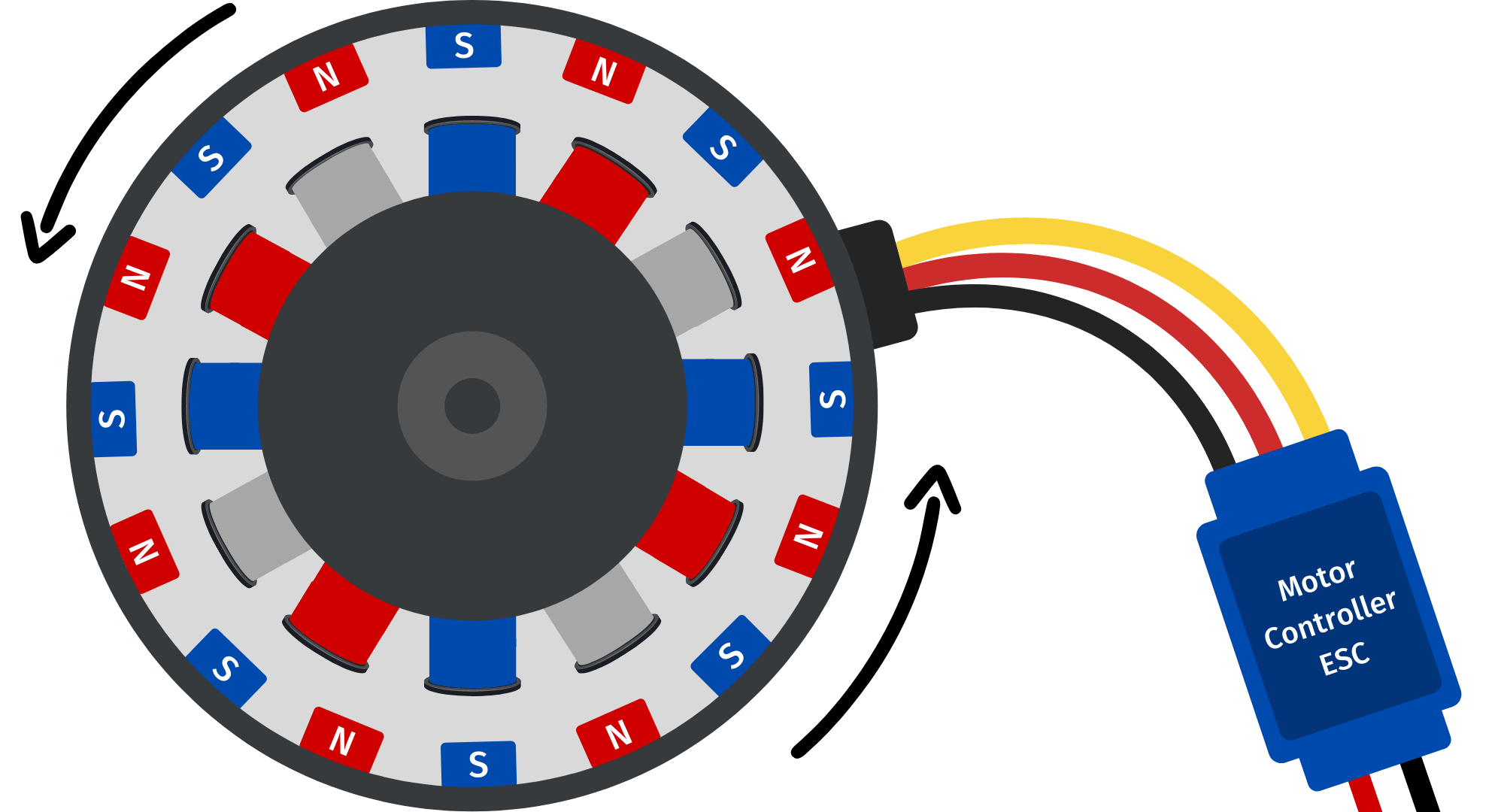
Brushless motors have better torque, power and efficiency, but are more difficult to control and require specialized electronics.
Ratings and Specifications
Voltage
Motors are rated by the voltage which can be applied to them without damaging them. A motors voltage rating is based on the thickness of the enamel coating of the wires (how much voltage the insulation can.. insulate), and if the amount of current the motor will pull at that voltage will result in it overheating.
Current
Even though a motors voltage rating is informed by it’s maximum current, motors are also rated by their burst current (generally 10 seconds) and their continuous current. These ratings assume open air, so if you bury your motor or otherwise seal it from being cooled, it might still burn out if you run it at it’s current rating.
Stall Torque
Measured in Nm, tells you how much torque the motor can put out when stalled, which for brushless motors, is generally their peak torque. Brushed motors are wack and have their peak torque at some point in the middle of their speed range.
KV
A motors KV is it’s speed per volt under no load. An 800 KV motor will rotate at 1600 rpm if driven with 2 volts and under no load. Lower KV motors have more torque and a lower maximum rpm.
Electronic Speed Controlers (ESC)
Both brushed and brushless motors are used with ESC’s which control the power and speed of the motor. A brushed ESC can be a single transistor simply turning on and off for varying amounts of time. Sometimes brushed ESC’s have an H-bridgeto allow for changing directions. Brushless ESC’s almost always have 6 transistors arranged in a |-|-| bridge to control all three coils inside the motor. Often they have software tuning and for sensored motors (motors with an encoder), they also have digital inputs for the encoder.
Different ESC’s accept different control signals, RC (remote control) hobby ESC’s usually take a 5v 2khz PWM signal from a remote control receiver, ESC’s in cars and FRC robots are controlled via CAN bus, and some fully integrated ESC’s have their own remotes and built in receivers.
Some ESC’s can also control several motors.
Battery Spot Welding
Cylindrical Li-Ion cells are generally assembled together with spot welded nickel strips. Thin nickel or steel strips between .1 and .3 mm are welded between the top and bottom of the cells like this:
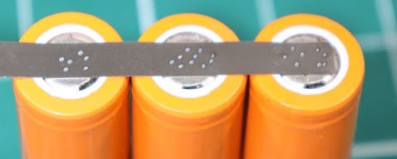
Spot welding works by applying a large pulse of current (50-200 amps) between two prongs about 5mm apart. Since the contact area between the prongs and nickel strip is of high resistance, most of the heating occurs right below the prongs, which leads to the nickel strip fusing so the battery cell under the prongs.

Parts
Battery pack
- 25 Samsung 25R 18650 cells (datasheet)
- A simple generic 10s li-ion BMS (User manual)
- Nickel strip and Spot welder (user manual)
- Cell frames (goober video)
Motors
- Dual 400w sensored hub motor truck
- ESC designed for those hub motors (video)
- Remote for that ESC
Other
- A deck
- Some materials to fabricate an electronics enclosure
- Spacers for trucks (if needed)
General Steps
Just so you’re not lost. Ur gonna have to figure allis out yourself
Decisions Decisions Decisions + Some decisions you don’t get to make
- Decide: Are you putting electronics on top or under? (Ground clearance + Electronics protection vs Aesthetics and usability)
- Are you putting motors in front or back? Do they work both ways?
- What shape is this enclosure going to be?
- Is the battery in a separate enclosure?
- You need to make a 10s2p battery. You have 20 cells. There are 5 extra.
- How will you arrange cells physically?
- Where will the BMS go?
Battery
This will depend on how you arrange the cells…
- Arrange cells in cell holders in some logical groups
- Use nickel strip to connect cells together
- Connect high current wires between battery, output, charging, and BMS
- Connect BMS cell tap wires
- Do any final assembly of cell groups
- Use rigid material (like corrugated plastic) to give the pack some mechanical strength
Board
- Mount trucks
- Decide if spacers are needed to achieve full turning ability
- Make spacers
- Remount trucks with spacers
- Mount baseplate for enclosure?
- Mount electronics to enclosure baseplate?
- Route wires and connectors into enclosure
- Connect everything
- Mount enclosure
- Test!
- Seal enclosure?
